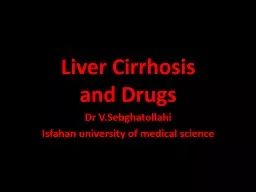

Liver dysfunction and Drugs metabolism Dr VSebghatollahi Isfahan university of medical science Liver Functions Metabolism Carbohydrate Fat amp Protein Secretory Bile acids bile salts ID: 762972
Download Presentation The PPT/PDF document "Liver dysfunction and Drugs metabolism..." is the property of its rightful owner. Permission is granted to download and print the materials on this web site for personal, non-commercial use only, and to display it on your personal computer provided you do not modify the materials and that you retain all copyright notices contained in the materials. By downloading content from our website, you accept the terms of this agreement.
Liver dysfunctionand Drugs metabolism Dr V.Sebghatollahi Isfahan university of medical science
Liver Functions: Metabolism – Carbohydrate, Fat & ProteinSecretory – Bile acids, bile salts & pigmentsExcretory – Bilirubin, drugs, toxins Synthesis – Albumin, coagulation factors Storage – Vitamins, carbohydrates etc. Detoxification – toxins, ammonia, etc.
Normal Liver
Cirrhosis
Introduction Cirrhosis is common end result of many chronic liver disorders.Inflammtion – healing with fibrosis - Regeneration of remaining hepatocytes form regenerating nodules. Loss of normal architecture & function.
INTRODUCTION It is generally considered to be irreversible in its advanced stages at which point the only option may be liver transplantation. However, reversal of cirrhosis (in its earlier stages) has been documented in several forms of liver disease following treatment of the underlying cause.
Etiology of Cirrhosis The most common causes of cirrhosis in the United States are:hepatitis Calcoholic liver diseaseNonalcoholic fatty liver disease which together accounted for approximately 80 percent of patients on the liver transplantation waitlist between 2004 and 2013
Etiology of Cirrhosis In developed countries, common causes of cirrhosis include :Chronic viral hepatitis (hepatitis B, C)Alcoholic liver diseaseHemochromatosisNonalcoholic fatty liver disease
Pathogenesis: Hepatocyte injury leading to necrosis.Alcohol, virus, drugs, toxins, genetic etc..Chronic inflammation - (hepatitis).Bridging fibrosis.Regeneration of remaining hepatocytes Proliferate as round nodules.Loss of vascular arrangement results in regenerating hepatocytes ineffective.
Normal Liver - Microscopy
Cirrhosis
cirrhosis :
Liver Biopsy – Cirrhosis
Liver Biopsy – Cirrhosis
Clinical Features Hepatocellular failure.Malnutrition, low albumin & clotting factors, bleeding.Hepatic encephalopathy.Portal hypertension.Ascites, Porta systemic shunts, varices , splenomegaly .
Physical examination Spider angiomas Palmar erythema Nail changes Muehrcke's nails Terry’s nails Gynecomastia Testicular atrophy
Cirrhosis Clinical Features
Ascitis in Cirrhosis
Clinical Manifestations Muehrcke's nails Terry’s nails
Spider angioma
Jaundice
Gynecomastia in cirrhosis
Prominent abdominal veins.
Conclusions: Common end result of diffuse liver damage. (Viral hepatitis, Alcohol, congenital, drugs, toxins & Idiopathic)Characterised by diffuse loss of architecture.Fibrous bands & regenerating nodules distort and abstruct blood flow. (inefficient function)Hepatocellular insufficiency & portal hypertension.Shrunken, scarred liver, ascitis, spleenomegaly, liver failure, CNS toxicity.
Drug metabolism
Metabolism The metabolism of drugs and other xenobiotics into more hydrophilic metabolites is essential for the elimination of these compounds from the body and termination of their biological activity.
Types of Metabolism Phase 1 Reactionsusually convert the parent drug into a more polar metabolite by introducing or unmasking a functional group (-OH, -NH2, -SH). Metabolite is usually inactive.Phase 2 Reactions - Conjugation an endogenous substrate (glucuronic acid, sulfuric acid, acetic acid, or amino acid) is attached to a functional group on the drug or phase I metabolite.
conjugate Phase I Phase II Drug metabolite with modified activity Inactive drug metabolite conjugate Drug Drug Drug conjugate Lipophilic Hydrophilic Absorption Metabolism Elimination
Biotransformation Generates more polar (water soluble), inactive metabolitesReadily excreted from bodyMetabolites may still have potent biological activity (or may have toxic properties)Generally applicable to metabolism of all xenobiotics as well as endogenous compounds such as steroids, vitamins and fatty acids
First-Pass Metabolism Following nonparenteral administration of a drug, a significant portion of the dose may be metabolically inactivated in either the intestinal endothelium or the liver before it reaches the systemic circulationLimits oral availability of highly metabolized drugs
Effects of Liver Disease on Drug Metabolism
Liver disease may have complex effects on drug clearance, biotransformation, and pharmacokinetics
There is no easily available measure of liver function, with the "liver function tests" such as AST, ALT, GGT & alkaline phosphatase providing an indication of liver cell damage rather than ability of the liver to metabolise drugs. This contrasts with renal disease, where estimates of renal function based on creatinine clearance correlate with renal drug elimination.
Type of Disease In liver disease the type of disease does matter: Hepatitis – not much effect Biliary obstruction – not much effect (initially) Cirrhosis – has major effects on drug handling Liver Dysfunction can lead to impaired drug metabolism-decreased enzyme activity First pass metabolism effected – may inc 2-4 x bioavailiability Results in exaggerated pharmacological responses and adverse effects
Assessing Function Assessing liver function is hard - no single test of how well the liver metabolises drugsDrug metabolism most likely to be impaired when the patient has cirrhosis, and has evidence of coagulation disturbances and low albumin
Pathogenetic factors(in cirrhosis) include: alterations in intestinal absorption alterations plasma protein binding alterations hepatic extraction ratio alterations liver blood flow portal-systemic shunting alterations biliary excretion alterations renal clearance
Sometimes alterations increase levels of bioavailable drug, causing normal drug doses to have toxic effectsHowever, levels and effects for an individual drug are unpredictable and do not correlate well with the type of liver injury, its severity, or liver function test results.
Thus, no general rules are available for modifying drug dosage in patients with liver disease .
Clinical effects can vary independent of drug bioavailability, especially in chronic liver disease; eg, cerebral sensitivity to opioids and sedatives is often enhanced in patients with chronic liver disease. Thus, seemingly small doses of these drugs given to cirrhotic patients may precipitate encephalopathy. The mechanism of this effect probably involves alterations in cerebral drug receptors
Adverse drug reactions do not appear to be more likely in patients with advanced liver disease however, such patients may tolerate any hepatic adverse effects of drugs less well.
Learn from the mistakes of others. You can't live long enough to make them all yourself…!